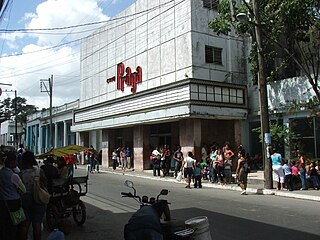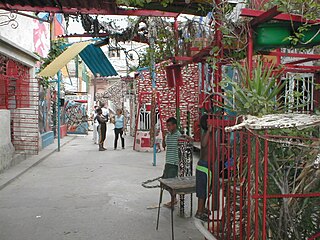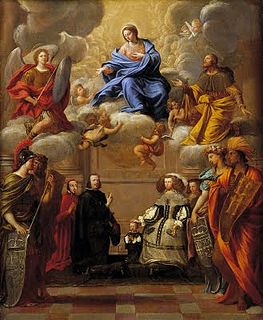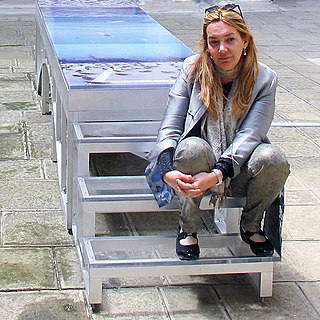This article has multiple issues. Please help improve it or discuss these issues on the talk page . (Learn how and when to remove these template messages)
|
Mario Perez (born June 17, 1943) is a Cuban artist.
This article has multiple issues. Please help improve it or discuss these issues on the talk page . (Learn how and when to remove these template messages)
|
Mario Perez (born June 17, 1943) is a Cuban artist.
Perez emigrated to the United States as a teenager and has focused his artistic career primarily on documenting the pre-war Havana of his youth. He is noted for his urban landscapes often recreated from memory. His work has become especially popular in Cuban expatriate communities, such as in south Florida, where collectors celebrate his ability to recapture the tone and atmosphere of 1940s and 1950s Cuba before the revolution. Perez works primarily in a combination of pen/ink and watercolor, though some of his most noted (and most overtly political) work appears in oil on canvas. These include "La Muerte de José Martí", depicting the death of the Cuban national hero and poet who led the nation's independence movement against Spain, and who died in a charge during the Battle of Dos Rios.
Perez is also known for his work in charcoal, in particular his series of portraits of jazz musicians, many of whom performed in Cuba prior to the country's fall to communism. As an untrained artist who grew up on the impoverished streets of Havana, Perez's family had no money to purchase art supplies, leaving him drawing with broken pencil nubs on scraps of paper. He left Cuba at the age of 15, after the death of his mother, and did not return for more than 40 years. A visit to Cuba in 2000, after receiving an entry visa from Fidel Castro's government, led to a particularly productive period in his work.
Perez's style is classified as primitive art, also called naive art, a category used to describe notable work produced by artists without formal schooling, such as Grandma Moses, and which captures instinctive artistic expressions without the typical conventions and uniformity of classically educated instruction.
Perez has a wife, Margaret, and three children. Perez currently resides in Yorba Linda, California.

Havana is the capital and largest city of Cuba. The heart of the La Habana Province, Havana is the country's main port and leading commercial center. The city has a population of 2.1 million inhabitants, and it spans a total of 781.58 km2 (301.77 sq mi) – making it the largest city by area, the most populous city, and the fourth largest metropolitan area in the Caribbean region.

Alberto Díaz Gutiérrez, better known as Alberto Korda or simply Korda, was a Cuban photographer, remembered for his famous image Guerrillero Heroico of Argentine Marxist revolutionary Che Guevara.

Afro-Cubans are Cubans who are of West African and largely of Yoruba ancestry and some Sierra Leonean ancestry. The term Afro-Cuban can also refer to historical or cultural elements in Cuba thought to emanate from this community and the combining of native African and other cultural elements found in Cuban society such as race, religion, music, language, the arts and class culture.

Cinema arrived in Cuba at the beginning of the 20th century. Before the Cuban Revolution of 1959, about 80 full-length films were produced in Cuba. Most of these films were melodramas. Following the revolution, Cuba entered what is considered the "Golden age" of Cuban cinema.

Cuban art is an exceptionally diverse cultural blend of African, South American, European, and North American elements, reflecting the diverse demographic makeup of the island. Cuban artists embraced European modernism, and the early part of the 20th century saw a growth in Cuban avant-garde movements, which were characterized by the mixing of modern artistic genres. Some of the more celebrated 20th-century Cuban artists include Amelia Peláez (1896–1968), best known for a series of mural projects, and painter Wifredo Lam, who created a highly personal version of modern primitivism. The Cuban-born painter Federico Beltran Masses (1885–1949), was renowned as a colorist whose seductive portrayals of women sometimes made overt references to the tropical settings of his childhood.

Publio Amable Raúl Martínez González, known as Raúl Martínez, was a Cuban painter, designer, photographer, muralist, and graphic artist. He is best known for colorful pop-art portraits of leading Cuban political figures including José Martí and Camilo Cienfuegos.

Pietro del Pò, also spelled del Po, was an Italian painter, engraver, and draughtsman of the Baroque. He was more distinguished as an engraver than as a painter.
Marta María Pérez Bravo is a Cuban artist who is best known for her black-and-white self-portraiture, in which she often uses her own body as the central subject-object to express her own belief in - and practice of - Afro-Cuban religions, particularly Santeria and Palo Monte. Much of her art is informed by this practice, and engages with the themes of ritual, motherhood and femininity, expressed through the highly stylized posing of her body, which is placed in relation to personally and ritually significant objects in her self-portraits.
Carmen Herrera was a Cuban-born American abstract, minimalist visual artist and painter. She was born in Havana and lived in New York City from the mid-1950s. Herrera's abstract works brought her international recognition late in life.

Josignacio is a Contemporary Cuban Artist, who first emerged in the controversial, "La Generacion de los 80s" - The 80s Generation of Contemporary Cuban Art also referred to as New Cuban Art.
Mario Orozco Rivera was a Mexican muralist and painter, a later proponent of Mexican muralism, and whose work was particularly influenced by David Alfaro Siqueiros. He created a number of murals, mostly in the state of Veracruz before becoming an assistant to Siqueiros, directing the Taller Siqueiros in Cuernavaca and working with the artists on projects such as the Polyforum Cultural Siqueiros. While preferring mural work, which he considered less commercial, Orozco Rivera also created oils and sculptures. Many of these works were exhibited in Mexico and abroad and can be found in many major collections. His work received recognition in various countries.
Leandro Soto is a multidisciplinary visual/installation and performance artist. He is also a set and costume designer for theater and film. Soto studied at Escuela Nacional de Arte National Art Schools (Cuba) and Instituto Superior de Arte, University of Havana. As an educator he has taught and lectured at various Higher Education institutions in the U.S. and abroad. Soto also founded a creative workshop, El Tesoro de Tamulte, in Tabasco, Mexico, from which professional artists emerged.

Enrique Rottenberg is an artist currently working with photography and installations. His artistic career is as plural as his national identity. Born in Argentina in 1948, to Jewish parents of Polish descent, he emigrated alone to Israel at the age of 13.

Sandra Ramos is a Cuban contemporary painter, printmaker, collagist, video and installation artist who explores nationality, gender, and identity in her work. She is known for works featuring her character of the Cuban Pioneer girl, who is composed of a self-portrait and an appropriated portion of an old illustration from 1895' L' illustration French magazine. Ramos currently lives in Miami, Florida, and serves as an artist in residence at Bakehouse Art Complex and a contracted exhibition artist at The Foutain Head Art Studios. She is also a renowned curator in Cuba, and she won a national award for her curatorial work on the exhibition La Huella Múltiple in 2003 from the Consejo Nacional de las Artes Plásticas (CNAP) in Havana, Cuba.
Carlos Alfonzo (1950–1991) was a Cuban-American painter known for his neo-impressionistic style. His work has been collected by Whitney Museum of American Art and Smithsonian Institution.
José María Mijares was a Cuban contemporary visual artist. He began drawing in his adolescent years and entered the San Alejandro Academy of Fine Arts on a scholarship at the age of 16. His greatest influences were the artists of the "Havana School": Carlos Enríquez, René Portocarrero, Cundo Bermúdez, as well as his professors, most notable being modernist painter Fidelio Ponce. He was also a part of the influential group, Los Diez Pintores Concretos, or as they are usually referred to, Los Diez. Although the group had a relatively short life, 1959-1961, and exhibited together only a few times, they remain an important part of Cuba's art history especially in the pre-Castro years and leading up to the revolution. He left Cuba in 1968, resigning his teaching position at the academy when Fidel Castro came into power. Based in Miami, he continued to be a prolific painter and until his death in 2004, at the age of 82.
Lourdes Gómez Franca, better known simply as Lourdes, was a Cuban-American painter and poet who was active in Cuba and the United States. Her work was significant in Miami and Cuban art communities of the later Twentieth Century and covered by many critics and scholars.
Ricardo Rodríguez Brey is a Cuban conceptual artist, sculptor, installation artist and draftsman.

Miguel A. Fleitas is a Cuban-American visual artist, photographer, and film director based in Miami, Florida. Fleitas was a television director and film editor for several popular television programs during his tenure with Univision and Telemundo. As an artist Fleitas has exhibited internationally, participated in high-profile exhibitions, and won awards since launching his art career in the 1980s. He is the son of Cuban filmmaker and artist Miguel Fleitas Sr.
Miguel Jorge (1928-1984), also known as “Micky” Jorge, was a Cuban artist who was influential in the establishment of South Florida's early Latin American art market in the Greater Miami area from the 1960s through the 1980s.